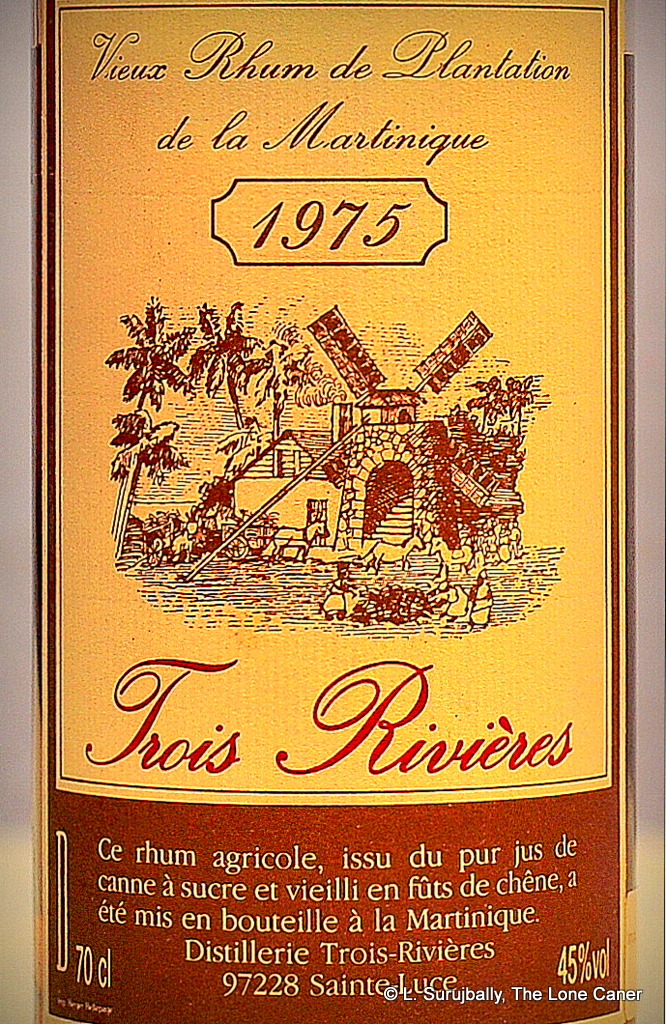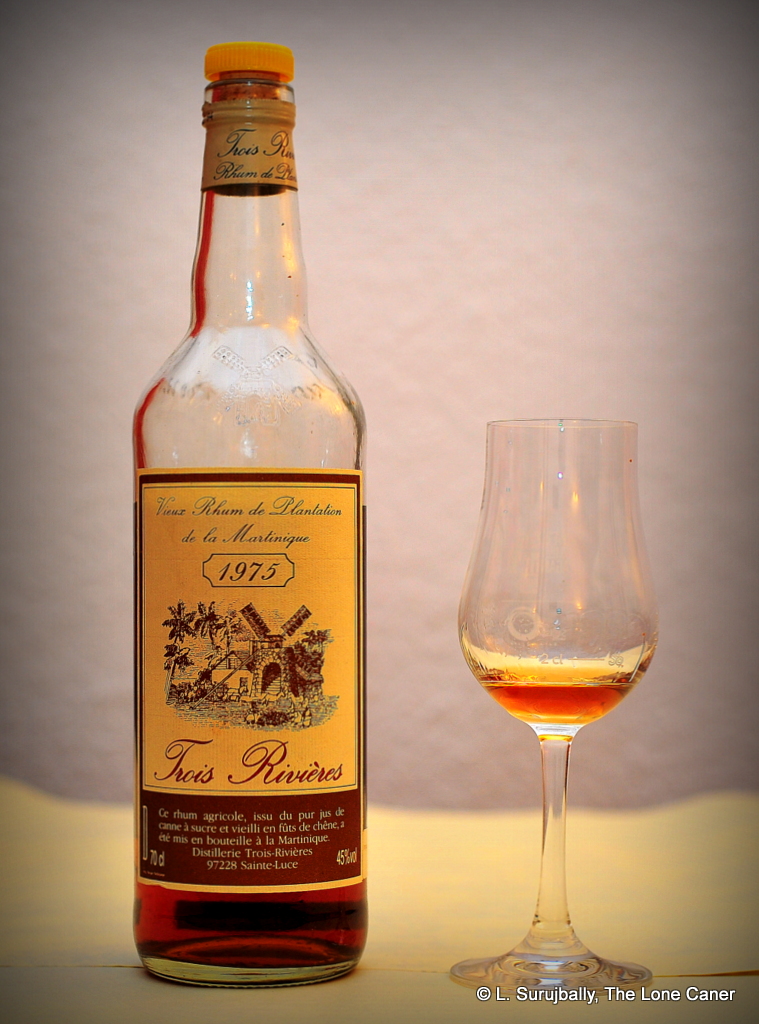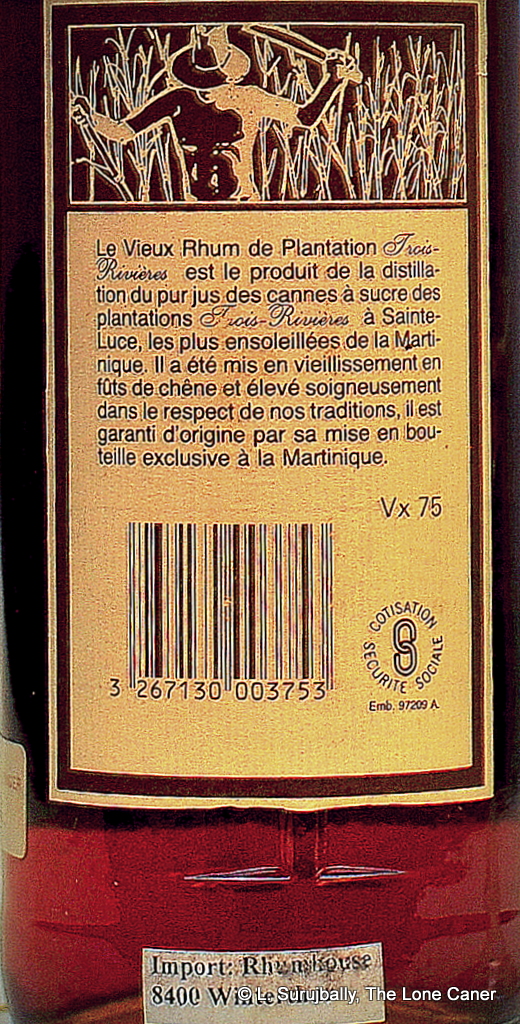
Proof that year of make does not confer exceptionalism.
Trois Rivieres in Martinique is over 350 years old, formed in 1660 when Nicolas Fouquet, Superintendent of Finances to Louis XIV, won a large concession of about 5,000 acres in the south of the island, where it remains still, after many changes in ownership. In 1953, the Marraud Grottes family, owners of their own distillery and the Duquesne brand, bought the estate and sold aged Trois Rivières Duquesne rhums under the brand until 1972. In 1994 the Trois Rivières distillery was acquired by the company BBS, which also had the La Mauny brand, and they’ve held on to it ever since. I thought that the 1977 millèsime might be the oldest one I’d ever get (and I’ve been keeping an eye on the 1953), but when I managed to source the 1975 (and 1986) millèsimes, well, I jumped.
Trois Rivieres is certainly one of those French island companies that prides itself in specific years’ output, perhaps more than any other rhum maker on the island – there are millèsimes from 1953, 1964, 1969, 1970, 1974, 1975, 1977, 1980, 1982, etc etc etc…you get the point. The really odd thing about them is that rarely, if ever, is it stated how old they are, aside from the “vieux” notation, meaning a minimum of three years ageing (see “Other notes” below). Which may be one reason why I thought the 1986 rhum was better than this one from eleven years earlier.

Presentation was a consistent yellow box for these oldies(I’ve seen several millèsimes with the same one) with that famous windmill, the year 1975, enclosing a slim bottle with the same info on the label…and surmounted with a tinfoil cap, which struck me as strange, but okay, perhaps when it was made wrapping and toppings were different. An amber red rhum gurgled invitingly within.
For a 45% ABV rhum, the 1975 was quite soft to smell, more so than the 1986. Nougat and vanilla flavours led right off, with more delicate, floral and grassy scents curling right behind them. Lighter fruit, raisins and dates followed swiftly, and while the 1975 was not entirely salty, some small element of brine was definitely there, as were faint rubbery notes and pencil shavings of the sort that used to litter my geometry set in primary school.
My contention is usually that an older rhum or rum is, on balance, a better one – the complexity that ageing imparts cannot be easily duplicated or faked, and if one tries enough products, sooner or later the difference is self evident. Hence my feeling that for all its supposed antecedents, the 1975’s ageing (whatever it was) was not sufficient to elevate it to the status of cult classic. I wasn’t terribly excited here: the taste was a bit thin, without as much depth and richness as one might expect. That’s not to say it was bad or lacking in complexity…because I tasted caramel, raisins, sugar water, honey, prunes, freshly sliced cucumbers, green grapes, more grass and some white guavas, and this was a pleasant melange to experience – it was a perfectly good nose, just not a great one.
The mouthfeel somehow also didn’t come up to par for something about which I had higher hopes (again, the 1986 tasted in parallel outclassed it) because of a lack of overall body and elegance of texture. Adding water did bring out some background flavours, mind you – more nougat, toffee, cafe latte, with the slight citrus taking something a back seat. The fade was all right, neither failing nor exciting, giving up some nice florals, nuts, a bit of leather and vanilla and subtler grassy notes. In other words, an above-average agricole, unaggressive, interesting and very easy to drink, which probably cost me too much. I think that in another year I’ll look at it again and share it around with the Rumaniacs, see if their opinion is the same.

It’s funny, in a very short space of time I’ve experienced two rhums that had older brothers, and in both cases those older ones were effortlessly outclassed by their younger siblings. The 1980 Chantal Comte decimated the 1977, and now the 1975 Trois Rivieres is not as good as the 1986. If there’s ever been a reason why I want more information on a label, this is it, because I’d dearly love to know if it was ageing that caused the difference in quality, or some other factor. If nothing else, this is perhaps why one should never take reported age or year of make alone as the sole arbiters of how good a rum “should” be – because here I got two that say exactly the opposite.
(#246. 85/100)
Other notes
So back to how old this thing is. Yes the “vieux” statement supposedly tells its tale. Cornelius, Henrik, Gregers and I pored over the labelling and the box to see if there was something that could give us a clue, and came up with this little mark at the bottom right of the label, where it says “Emb. 97209 A”. Could that mean bottled in 1997-2-09 or 1997-20-9? If that were true, the thing is 22 years old. But in that case, why not say it is a très-vieux, or XO? On the other hand, it could refer to the postal code of Fort de France on Martinique, so don’t take my conjecture as gospel. The mystery deepens until Trois Rivières (or any reader) can provide more information.
Hi Lance,
The Emb. code refers ’emballage’ code. Every producer in France has one, and I believe it is an attempt to make products (and spillage) traceable. Nothing to do with the bottle date though.
I do believe that most of these vintage 3 rivieres carry a laserprint bottle code on the capsule. As the 1980 vintage does carry a vintage, I wonder if it also carries a laserprint. If it does, could you perhaps post it so that with a few dated bottles, we might be able to crack the code?
Cheers,
Emile
I’ll check when I get back to my stash in October. I have the 1975 and 1986 vintages there, so I hope one of them will tell the tale. (ps: When you say the capsule, are you referring to the cork, or some other location on the bottle?)
Yeah, sorry I meant the 1986. The print code would be on the foil of the capsule. I’m unsure whether the 1975 would already have a print code though, as it appears to have bottled in 2nd half of the 1980s, as it carries a modern-style barcode and the cotisation icon, but not yet the recycle icon. But the 1986 should have one. Later bottlings have a print code with the exact year on them but earlier ones are a bit more cryptic, hence my question 🙂
I’ll definitely check. Thanks for the advice.
Yes 97209 is definitely the postal code, but i guess you figured that out since then 😉